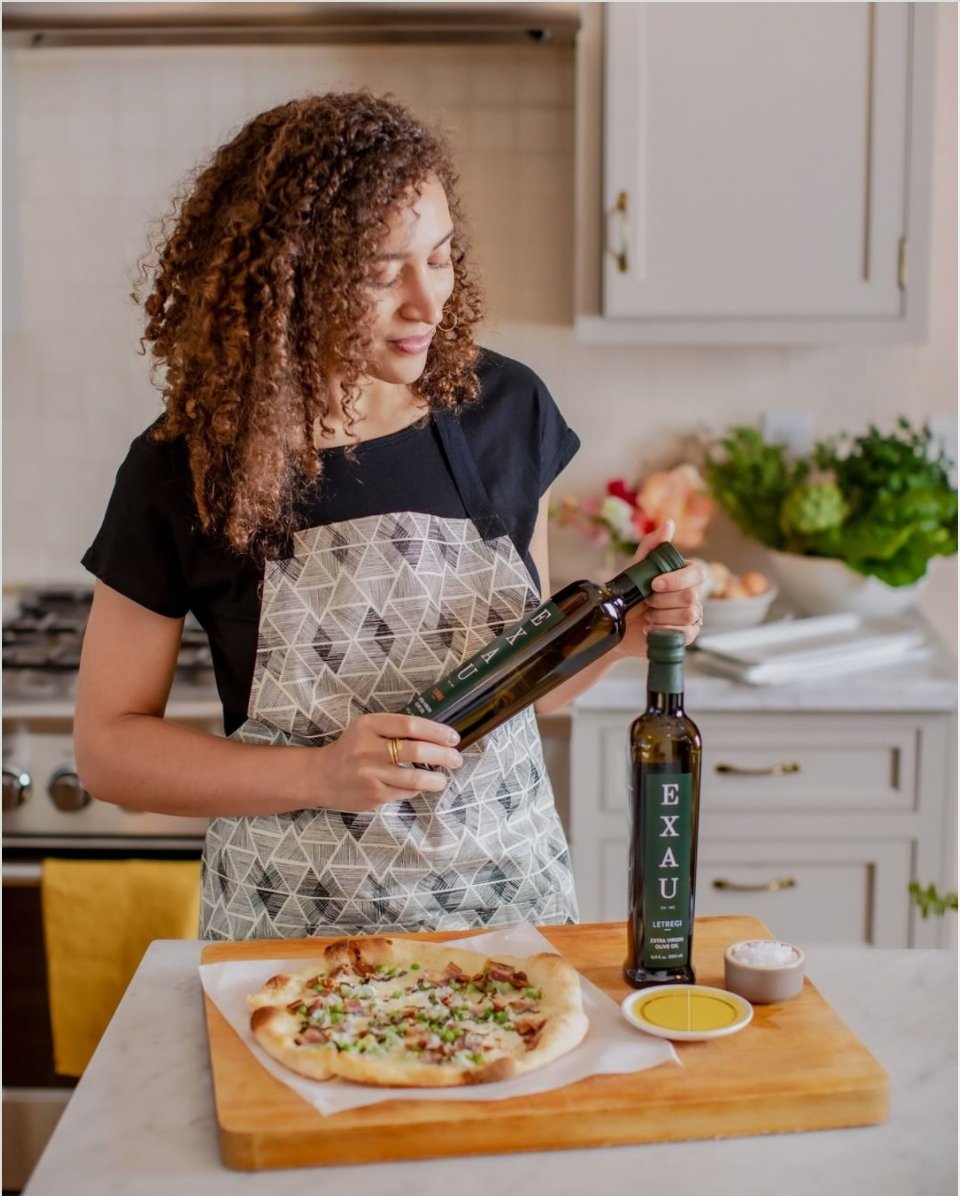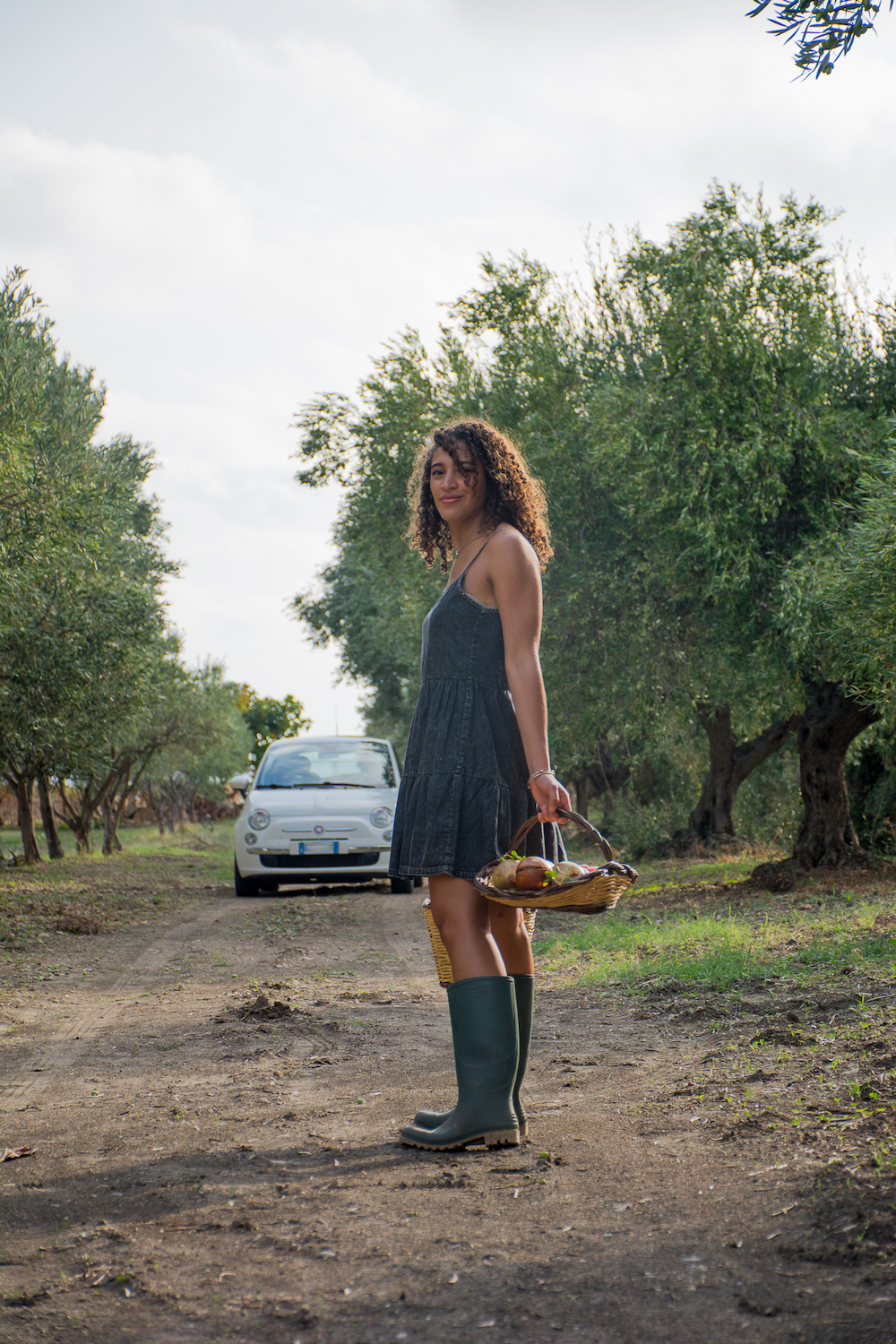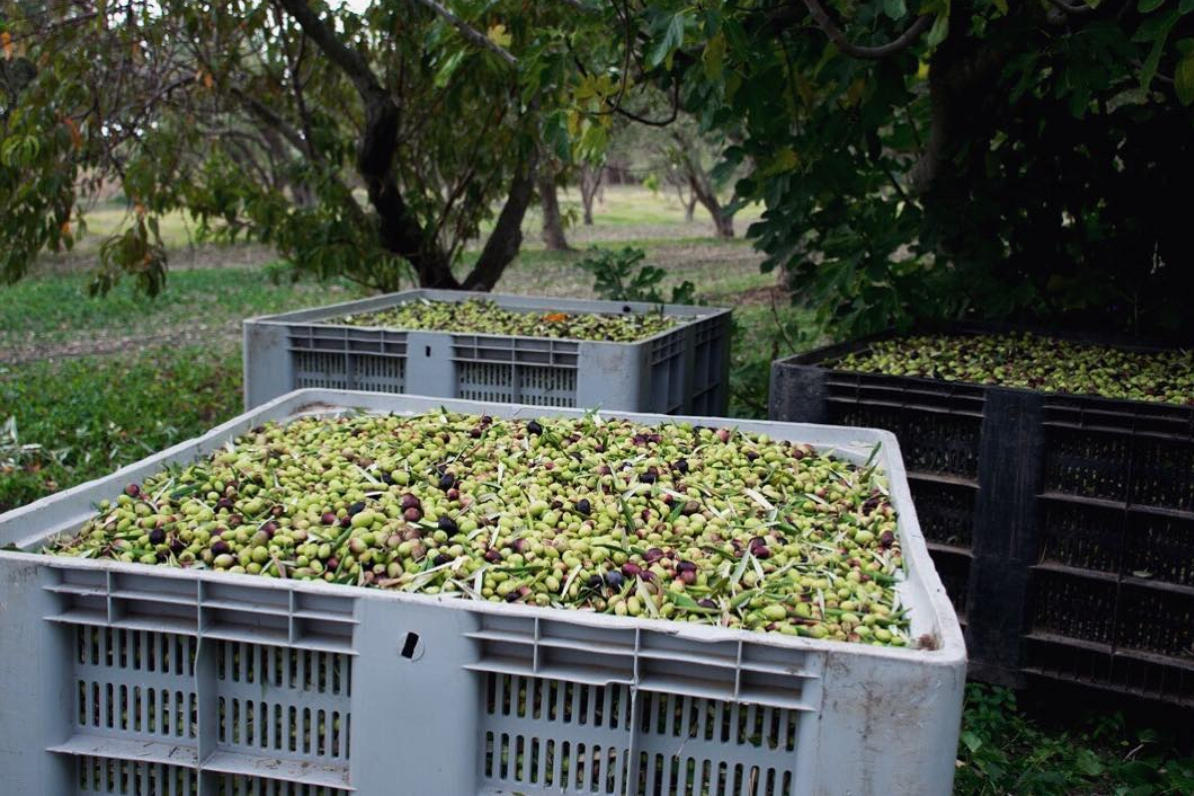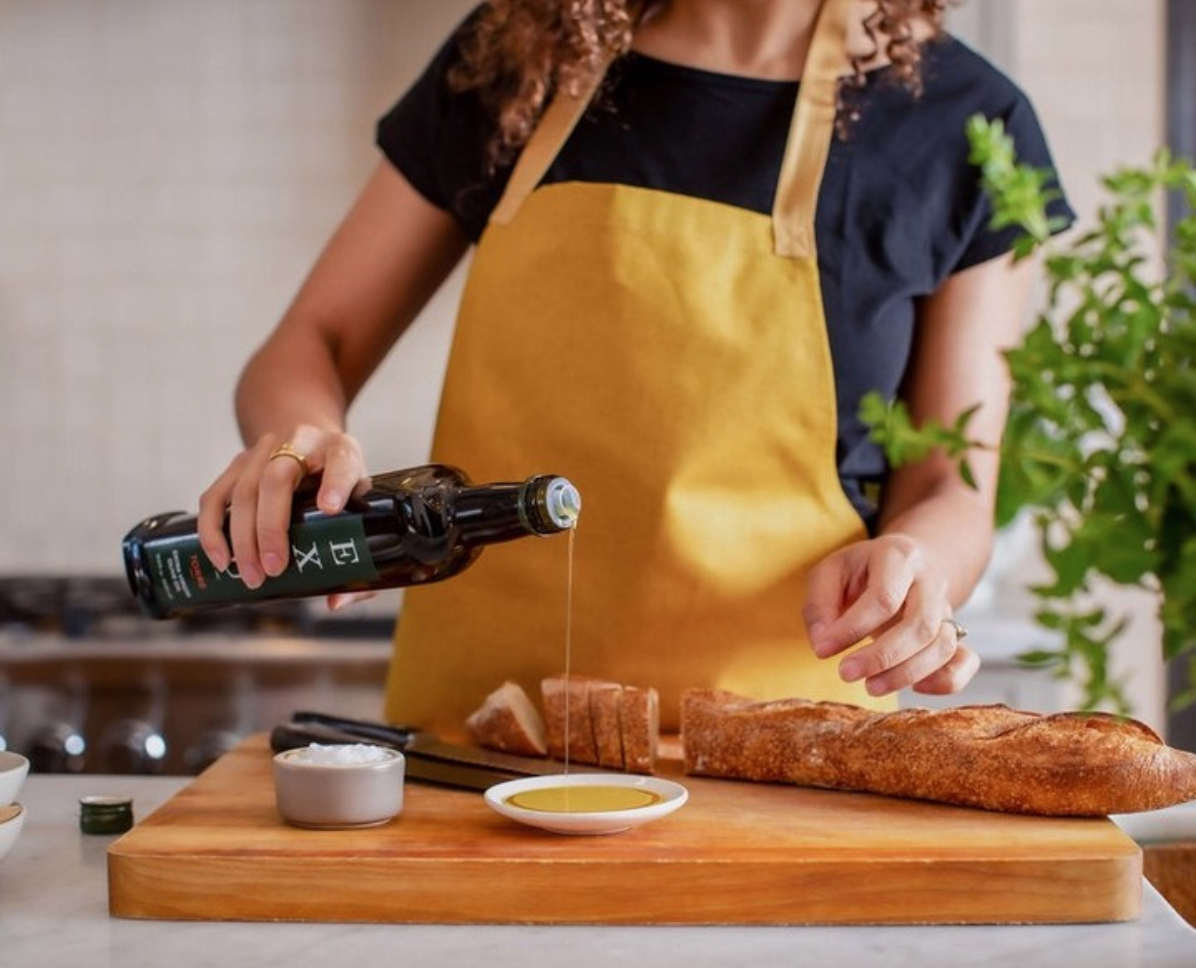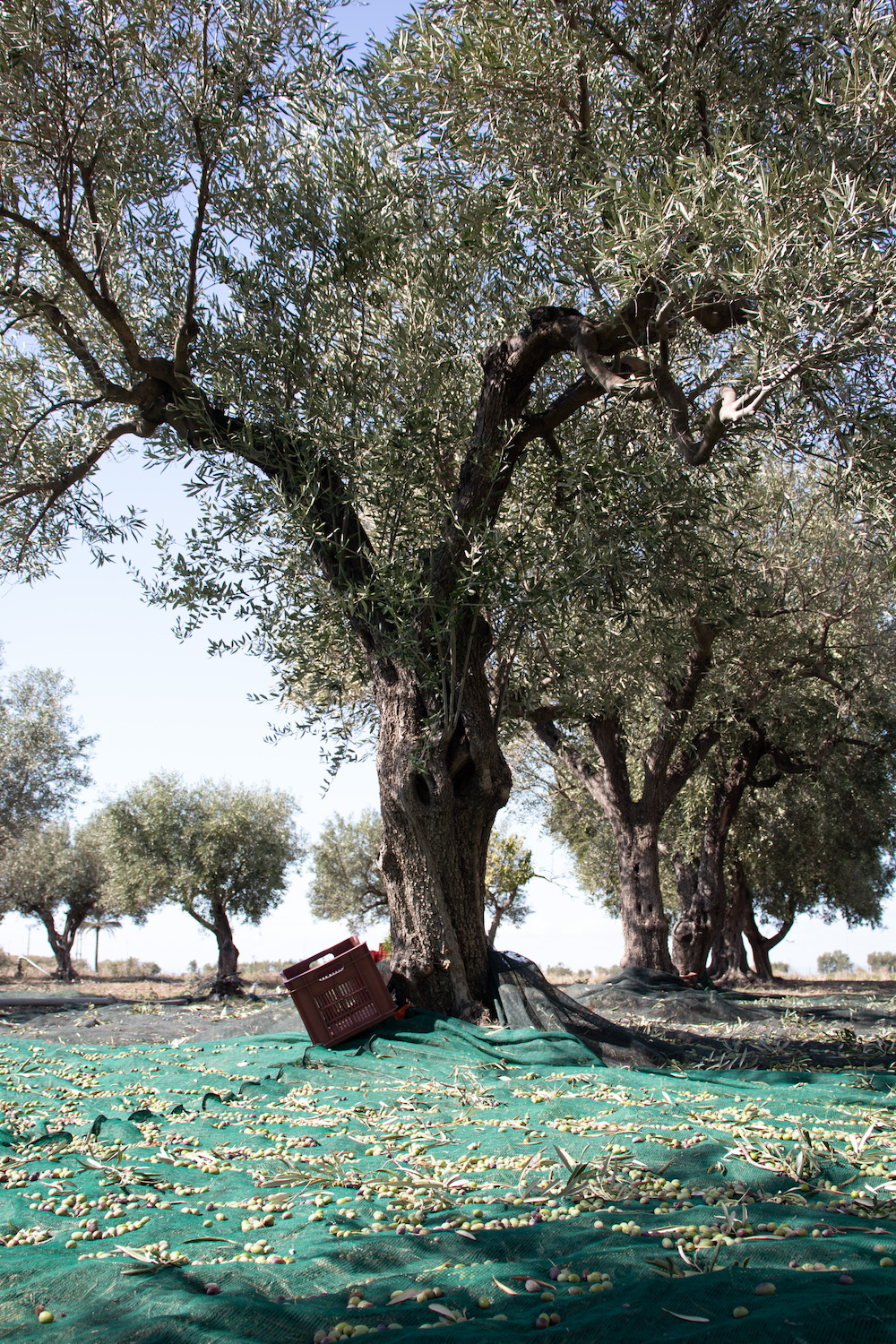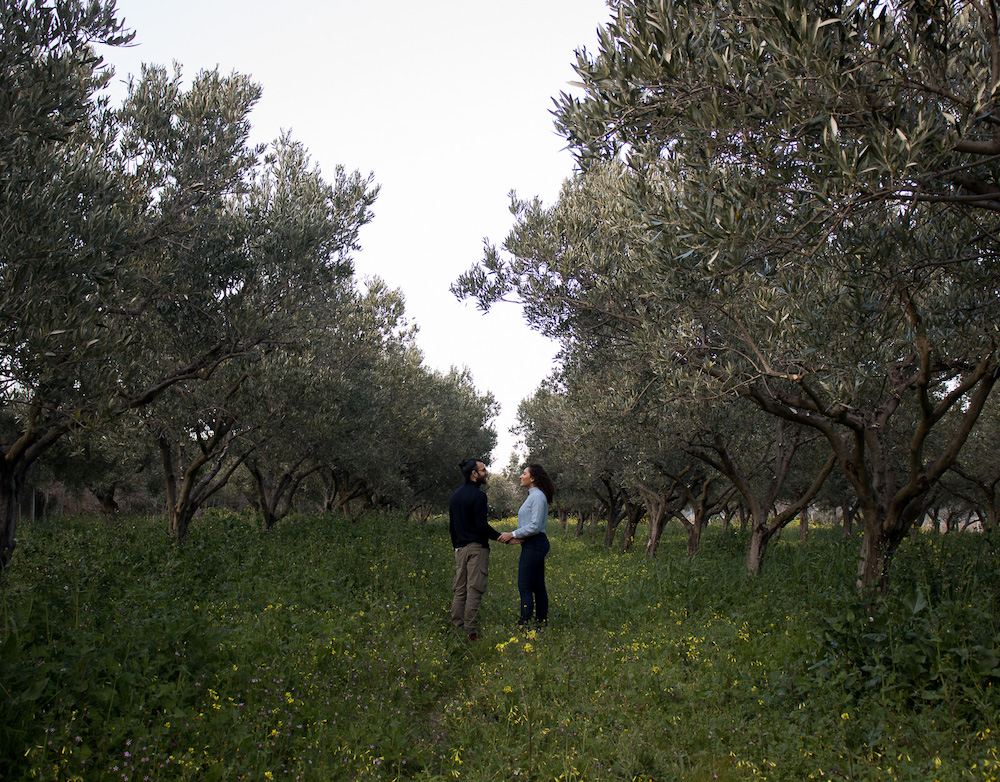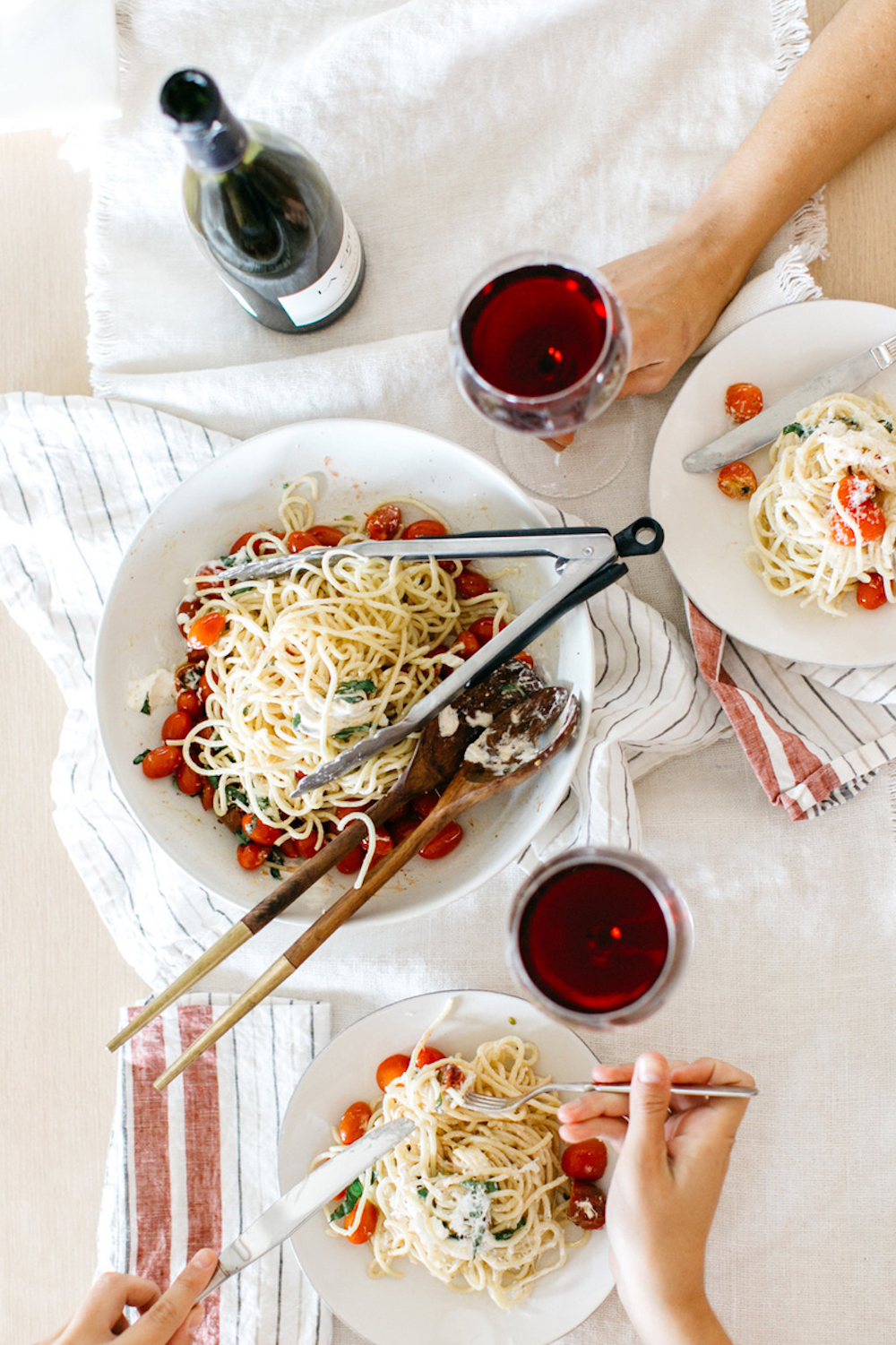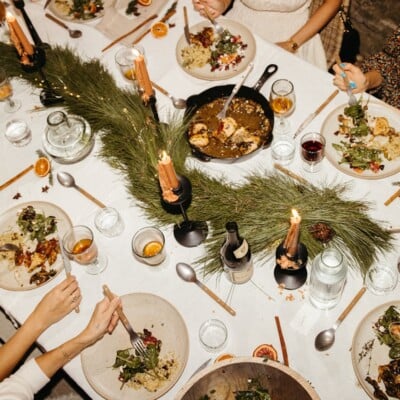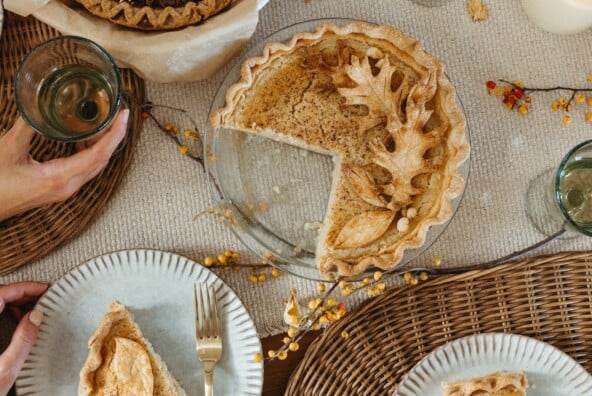Dislaimer: this isn’t really a story about olive oil. At least, not entirely.
This is the story of an inspiring, creative woman who fell in love: with the bounty of nature, with culinary delights, with Italy – and with an Italian man. No, it’s not a scene from Eat, Pray, Love (though it’s romantic enough to be.) It’s the founder’s story behind award-winning EXAU olive oil, the creation of husband and wife team Skyler Mapes and Giuseppe Morisani.
Skyler first appeared on my radar when I shared this post at the beginning of the Black Lives Matter movement, and she commented on the challenges of being a black woman in the agriculture industry. She said “I have yet to meet another female black olive oil producer,” and of course: I immediately had to know her story. We took our conversation to email, then to Zoom, and by the time I got off our call, I was not only girl crushing, I was obsessed with the passion and craftsmanship that Skyler and Giuseppe bring to their brand and their olive oil.
Giuseppe is a nutritionist and third generation olive oil producer from Calabria, Italy. Skyler is a third generation Californian with a passion for design and winemaking. Read on for the story behind their incredible company (and yes, their love story, too), and Skyler’s tips on how to buy and use really good olive oil at home. You’ll want to get cooking, stat.
How did you get into the olive oil business?
I graduated with a degree in architecture from Arizona State University, and later worked in the architecture and structural engineering industries, so my background definitely isn’t in agriculture! My dream was to design luxury homes and high end hotels and restaurants. I’m a very creative person, but found the design industry limiting (the opposite of what I wanted). I wanted to explore other career paths but didn’t know how, then Giuseppe came up with the wild idea to start an olive oil company. At first, I said, “absolutely not,” but he had planted a seed. I became curious about the agriculture industry, and had a friend who had co-founded a winery in the Bay Area and was the head wine maker. I asked her if I could work with them during their fall crush (the process of pressing the grapes in order to make wine), and she said yes. That was one of the best decisions I ever made.
Making wine is very similar to making extra virgin olive oil, except with olive oil there’s no aging process. My time at the winery taught me how to work with large scale industrial equipment and fresh fruit. Giuseppe and I started planning our olive company, and in 2017, we moved to Le Castella, Calabria; Giuseppe’s hometown of 1,400 people.
We decided that if we were going to start an olive oil company we had to go through every single step of the process ourselves: harvesting, pressing, bottling, labeling, palletizing, importing, sales, and marketing.
We would be as transparent as possible with our customers and bring them a little piece of Calabria. Our first harvest arrived in the U.S. in 2018. We sold out of oil in 6 months and knew we were onto something.
How did you and Giuseppe meet?
Giuseppe and I met the summer of 2014 in Rome! At the time I was living and interning at an architecture firm in Barcelona, and he was living and studying in Rome. A few weeks into our internship, my roommates and I decided to go to Rome for the weekend. I met Giuseppe the second night there, and we spent the rest of the weekend together. He promised he would come visit me in Barcelona if I would fly back to Rome, then drive seven hours down to Calabria with him to meet his mom. I thought he was mad, but said yes (because, why not?!)
We arrived in the tiny coastal town of Le Castella at night. His parents opened the door and greeted us. We went into the kitchen where Giuseppe’s mom had prepared a huge meal, truly enough food for 16 people. There was seppie fritte, fried littlefish, parmigiana, and so many foods sott’ olio (under oil). It was a very traditional Calabrian meal. While we were eating, Giuseppe’s mom was leaning on the table to my right staring at me. I was growing concerned, so I asked Giuseppe why she was staring at me. He asked her and she said she was watching me to see “if I was enjoying the food” (something we laugh about til this day.)
A few days later Giuseppe asked me if I wanted to meet his olive trees.
We picked fresh fruit, I ate a raw olive (they’re so bitter, FYI), and it was on that trip that I tasted real olive oil for the first time. I ended up extending my trip in Calabria from for another week.
What do you love most about running an olive oil company?
The people! We get to meet and work with so many talented and kind people: our chemist, the bottle manufacturer, travel planners, chefs, other entrepreneurs, and most importantly our customers! We are lucky to straddle life in Texas and south Italy.
Calabrians appear rough on the outside but they are some of the nicest, most genuine people I’ve ever met. Family and friends from Giuseppe’s hometown help us harvest, bottle, or package product just to spend time with us during harvest. It’s really special. In the US, we participate in events with talented artisans and meet our customers in person. Texas in particular has been very welcoming to our business and I’m blown away by the support that we have received from the community. Now we’re mostly spending time with customers virtually, we thought this would limit us but we’ve grown quite a bit!
Tell us about the harvest in Calabria (we’re all starving for travel stories right now!)
We do the harvesting process ourselves! Harvest usually starts the last weekend of September and runs through early December, though dates vary depending on the cultivar of the tree and the type of oil the producer wants to create.
How olive oil is made:
First, we lay down huge nets in order to catch the olives and avoid contamination; we don’t want the olives touching the ground. Then we use a branch shaker AKA the ‘scuotitore’. It looks like a weed wacker but instead of a spinning head at the top there’s a claw (imagine a crab claw) that grabs onto the olive branches. The branch shaker literally shakes the olive branch causing the olives to fall into the nets. The olives are then collected into bins and transported to the press. We start harvesting at first light and only harvest for six hours before going to the press in order to ensure our oil is of the highest quality. It’s more work, but it’s worth it.
We race to the press which is owned by our chemist and his family. Knowing who owns and maintains the press is extremely important because this process could destroy our product if not done properly. The olives arrive at the press in giant half ton bins and are immediately poured into the deleafer which removes any twigs or stems. The olives are then poured into hopper #1, transported up the ladder and down into the washing station, they then hop down the drying rack into hopper #2. Then the olives are transported up another closed ladder into the slicer which finely dices the olives. The olives then enter the crusher which churns them into a very fine paste (think olive tapenade). Now for the fun stuff, the olive paste is pumped into the centrifuge where the ‘pressing’ happens. The centrifuge is a giant steel tube and sounds way cooler than it is, we can’t see what’s happening inside, however we do know that the centrifuge separates vegetable water from the oil and spits any pits and skins out through another tube. The oil is then moved through a rough filter and eventually to a secondary filter. From the secondary filter vibrant, beautiful olive oil comes out!
The olive oil that comes straight out of the machine is known as ‘olio nuovo’, it is not filtered or decanted and should be consumed somewhat quickly. The producer has the option to decant or filter the oil which will create a more shelf stable product. Most of the oil we see on supermarket shelves in the U.S. is filtered.
So what happens to the pits and skins? The centrifuge spit them out. This discard is called ‘sansa’ and has a mulch/soil like texture and should be very green. It’s used to create pellets or fed to livestock since it’s rich in nutrients! Nothing goes to waste when making olive oil.
What’s the biggest misconception about olive oil that you hear?
Myth 1: “You can’t cook or fry in extra virgin olive oil.”
On the contrary, you absolutely CAN cook with olive oil. In fact, people have been cooking and frying with olive oil for thousands of years. We cook and bake with it regularly and Giuseppe’s mom even fries with it over an open flame!
Myth 2: “The flavor of olive oil ‘disappears’ when you cook with it.”
Actually, a high quality olive oil builds the flavor foundation for your dish. For example, when I make Pasta al Pomodoro I start with a heavy pour of olive oil on medium-low heat. I add 1-2 smashed garlic cloves to the pan in order to ‘scent’ the oil. The delicate flavors of garlic will infuse the oil and be transported through the rest of the dish. Once I add the tomatoes they will melt, reduce, and meld perfectly with the oil. The oil will also help create an ‘adhesive’ to the pasta, coating it perfectly.
Myth 3: “Olive oil doesn’t go bad. It lasts forever!”
Incorrect. While technically speaking olive oil doesn’t “expire,” it absolutely does become rancid. In fact, many people have rancid oil in their pantries and don’t even know it. Rancid olive oil is an oil that has defects or has completely deteriorated. Very rancid oil may smell like cheese, salami, or even vinegar. Oil becomes rancid over time and through exposure to oxygen and sunlight. If you have a bottle of olive oil from 2017 harvest, it’s most likely rancid due to its age. With that said, please stop saving your “special oil.” Everyday is a special day and every meal is a special meal. Enjoy it!
Does it really matter where our olive oil comes from?
It matters! We live in a world where everything is on demand and instant. However, that goes against the rhythm of mother nature, especially olive trees. It takes between five to seven years for an olive tree to produce enough fruit to make oil, olive trees can teach us a lot about patience.
There are over 400 known cultivars (varieties) of olives in Italy alone. The flavor profile of an oil depends on the cultivar and location of the estate. Terroir is just as significant in olive oil as it is in wine. I notice some olive oil companies in the U.S. will try to emulate Italian olive oil, however Tuscany and Sicily have their own terroir so these names are very misleading. It’s important that the label clearly states where the oil is from.
Calabrian oil is special for many reasons: the region produces almost 1/3 of all of Italy’s olive oil, Calabrian oils are medium-bodied and fruit-forward, and the groves span from the coast to the mountains creating a a magical amount of biodiversity. Two years ago, we worked with an olive grove up in the mountains where the trees were over 300 years old and protected by the government. They were growing on very steep hills, so the owners had to harvest with cattle!
Our trees sit on a flat piece of property about 300 meters back from a cliff that drops off to the clear Ionian sea. They have an incredible view, the sun rises over the sea and sets into the hills.
The trees love the breeze from the Ionian and the long hot summers. All of these elements are contributing to the fruit-forward yet bright herbaceous notes present in all of our oils.
How do I choose a good olive oil when I’m grocery shopping?
The best way is to purchase from a producer or importer that you know operates with integrity and transparency. If that is not possible then these are the rules I would follow:
- Look for a dark bottle. Olive oil does not like light because it deteriorates the oil.
- Check for a harvest date. A bottle date and harvest date are not the same. The bottle date is when the already made oil was put into the bottle. You want to pick the newest harvest date: when the olives were picked from the tree and made into oil.
What are a few of your favorite recipes to make at home where olive oil plays a starring role?
Pasta Aglio e Olio. I call it a simple Italian mac and cheese, because there is something so nostalgic about making and eating that dish. This recipe is Giuseppe’s creation, who is secretly a recipe fanatic and becomes obsessed with perfecting a dish. I’ll catch him in the kitchen toasting breadcrumbs differently or experimenting with different garlic. I could seriously write a whole book about his recipe experiments.
Parmigiana is one of the very first things I ate when I arrived in Calabria and met Lina, Giuseppe’s mom, for the first time. This is her recipe, and it was recently featured in La Cucina Italiana USA. It’s decadent, yet light, and brings me so much comfort to prepare and eat.
When we fry the eggplants, I’m transported back to Lina’s kitchen in Le Castella where the sea breeze flows through the window and the scent of frying eggplant wafts up the stairs and into our shared hallway.
That’s what Calabria smells like for me.
This salad dressing is my creation, and you can use it on whatever you fancy. It’s so simple, and my favorite thing is to make it a day or two ahead of time and toss it with simple romaine or butter lettuce. Texture is huge for me when I eat, so the tiny pieces of black pepper and salty anchovy with the butter lettuce are my favorite.
All of these recipes use a delightful amount of olive oil!


